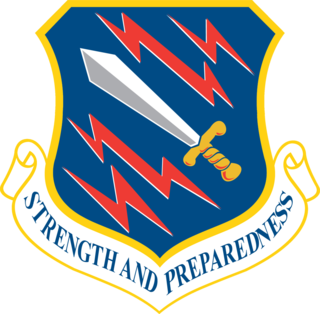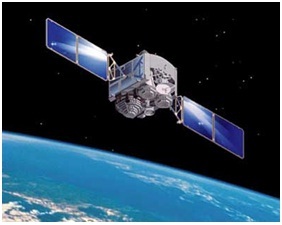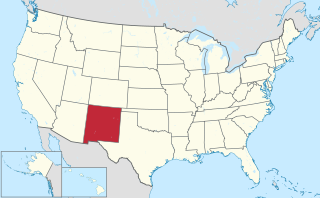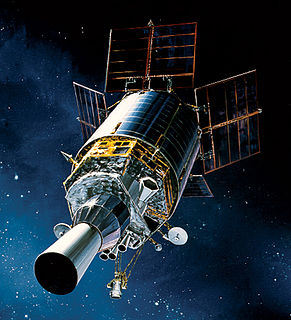
Buckley Air Force Base is a United States Air Force base in Aurora, Colorado, that was established by the U.S. Army as an auxiliary field and bombing range in 1938, and activated as a designated installation in 1941. The base was named in honor of World War I Army pilot First Lieutenant John Harold Buckley.

The 850th Space Communications Squadron is an inactive United States Air Force unit. It was a component of the 50th Network Operations Group, 50th Space Wing, Schriever Air Force Base, Colorado. The squadron was activated 1 December 1997 as the 850th Communications Squadron and redesignated the 850th Space Communications Squadron on 1 October 2002. It was inactivated on 31 January 2006, most of its functions and personnel having been incorporated into the 50th Space Communications Squadron.

The 21st Space Wing is a unit of the United States Air Force Space Command based at Peterson Air Force Base, Colorado. The unit is tasked with the operation of early missile warning and space object detection equipment around the world in support of NORAD and USSTRATCOM through a network of command and control units and ground-based sensors operated by geographically separated units around the world.

The 168th Wing is a unit of the Alaska Air National Guard, stationed at Eielson Air Force Base, Fairbanks, Alaska. Before it was redesignated in February 2016, it was known as the 168th Air Refueling Wing. If activated to federal service as a USAF unit, the 168 WG is primarily gained by Pacific Air Forces, while its 213th Space Warning Squadron is gained by Air Force Space Command.

The United States Air Force's 3d Space Operations Squadron was a satellite operations unit located at Schriever Air Force Base, Colorado.

The United States Air Force's 4th Space Operations Squadron is a satellite operations unit located at Schriever AFB, Colorado. 4 SOPS is responsible for command and control of the Milstar/Advanced Extremely High Frequency, Defense Satellite Communications System Phase III, and Wideband Global SATCOM satellite constellations. The 4th Space Operations Squadron's mission is to operate the Air Force's protected and wideband MILSATCOM systems. They provide warfighters global, secure, survivable, strategic and tactical communication during peacetime and throughout the full spectrum of conflict. The squadron also operates three mobile constellation control stations at various locations in conjunction with host partners. At higher readiness levels and during exercises, these personnel deploy with U.S. Strategic Command and U.S. Northern Command respectively.

The 50th Space Communications Squadron is a squadron of the United States Air Force located at Schriever Air Force Base, Colorado. The squadron provides command and control systems, configuration control, and systems integrations for seven Department of Defense space programs including $6.2 billion Air Force Satellite Control Network supporting $50 billion in national satellite and terrestrial systems for United States, allied, and coalition forces.

The 460th Space Wing is located at Buckley Air Force Base, east of Aurora, Colorado The 460th delivers global infrared surveillance, provides worldwide missile warning and tracking for homeland defense purposes, and deploys personnel to combatant commanders worldwide.

The 140th Wing is a unit of the Colorado Air National Guard, stationed at Buckley Air Force Base, Aurora, Colorado. If activated to federal service, the Wing is gained by the United States Air Force Air Combat Command.

The 162d Combat Communications Group is an inactive unit of the California Air National Guard. It was headquartered at North Highlands Air National Guard Station near Sacramento, California.

The 2d Space Warning Squadron Is part of the 460th Space Wing at Buckley Air Force Base, Colorado. It operates the Space-Based Infrared System satellites conducting global monitoring for significant infrared events.

The 6th Space Warning Squadron is located at Cape Cod Air Force Station, in Sandwich, Massachusetts. It operates the PAVE PAWS radar to watch for submarine launched and intercontinental ballistic missiles launched toward North America. The squadron is assigned to the 21st Space Wing, Peterson Air Force Base, Colorado. The squadron was first organized in October 1979 as the 6th Missile Warning Squadron

The 11th Space Warning Squadron is a United States Air Force missile warning squadron, located at Buckley Air Force Base, Colorado.

The 12th Space Warning Squadron is a United States Air Force ground-based radar used for missile warning, missile defense, and space situation awareness, stationed at Thule Air Base, Greenland.

The 19th Space Operations Squadron is an Air Force Reserve space operations unit, located at Schriever Air Force Base, Colorado.

The United States Air Force's 9th Space Warning Squadron was a United States Air Force missile warning unit located at Robins AFB, Georgia.

The 30th Operations Group is an operational component of the United States Air Force 30th Space Wing, stationed at Vandenberg Air Force Base, California.






























